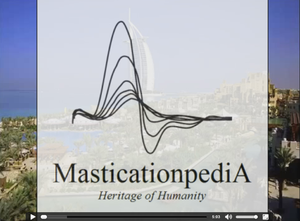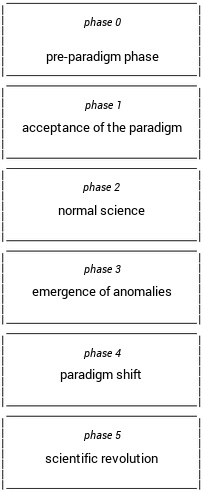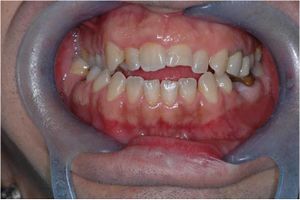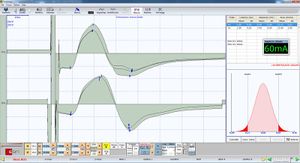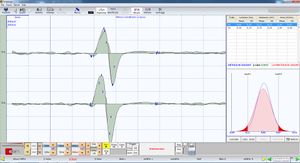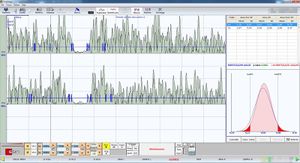Difference between revisions of "Introduction/de"
(Created page with "Im vorgestellten Fall wird die Frage in folgender Sprachlogik gelöst:") |
(Created page with "Die Untergruppen des Kausystems (Zähne, Okklusion, Kiefergelenke, Muskeln usw.) befinden sich in einem Zustand der "Kohärenz" mit dem zentralen Trigeminusnervensystem (siehe...") |
||
| Line 519: | Line 519: | ||
Im vorgestellten Fall wird die Frage in folgender Sprachlogik gelöst: | Im vorgestellten Fall wird die Frage in folgender Sprachlogik gelöst: | ||
| − | : | + | :Die Untergruppen des Kausystems (Zähne, Okklusion, Kiefergelenke, Muskeln usw.) befinden sich in einem Zustand der "Kohärenz" mit dem zentralen Trigeminusnervensystem (siehe Abbildungen 1b, 1c und 1d), daher kann der Begriff "Malokklusion" nicht verwendet werden, sollte stattdessen der Begriff „Okklusaler Dismorphismus“ in Betracht gezogen werden. |
:{{q2|This does not mean abolishing prosthetic, orthodontic and orthognathic masticatory rehabilitation treatments: on the contrary, this forma mentis tends to restore medical knowledge to dental rehabilitation disciplines, as well as offering an alternative to the scientific reductionism that converges in a deterministic interpretation of the biological phenomenon.|}} | :{{q2|This does not mean abolishing prosthetic, orthodontic and orthognathic masticatory rehabilitation treatments: on the contrary, this forma mentis tends to restore medical knowledge to dental rehabilitation disciplines, as well as offering an alternative to the scientific reductionism that converges in a deterministic interpretation of the biological phenomenon.|}} | ||
Revision as of 17:22, 19 June 2021
Wir möchten, dass unser Leser die Themen, die in Masticationpedia diskutiert werden, sofort wahrnimmt. Wir werden einige der aktuellsten Fragen zur erkenntnistheoretischen Entwicklung der Wissenschaft im Allgemeinen und der medizinischen und zahnmedizinischen Medizin im Besonderen behandeln.
Sie können sich auch ein video of ours auf Youtube ansehen.
Einführung
In dieser Phase werden wir zwei grundlegende Aspekte des Fortschritts der Wissenschaft gemäß den Kuhn-Paradigmen und der Erkenntnistheorie betrachten, die die Konzepte der "statistischen Inferenz" und "statistische Inferenz" in Frage stellen "Interdisziplinarität".
Diese beiden Themen, die anscheinend in Konflikt miteinander zu stehen scheinen, da das erste "Disziplinarität" benötigt, um die "Anomalien im Paradigma" hervorzuheben, und das zweite "Interdisziplinarität" benötigt, werden sie durch integrieren ein auflösendes Element, das aus "metakognitiven Gerüsten" besteht, dh kognitiven Brücken zwischen Fachdisziplinen. In diesem Zusammenhang wird der Leser daher besser in der Lage sein, die stochastische Herangehensweise an eines der umstrittensten Themen bei Kaurehabilitationen wie Malokklusion zu verstehen, von denen die meisten stammen die Kau-Rehabilitationsverfahren wie Kieferorthopädie, Prothese und orthognathische Chirurgie.
Neben der Vorwegnahme des wissenschaftlichen und philosophischen Aspekts von Masticationpedia werden wir uns schließlich auf Themen wie "Komplexe Systeme", das "Emergent Behaviour" komplexer Systeme und "System's Coherence" konzentrieren: notwendige Schritte zur Einführung wissenschaftlicher klinischer Themen, die dies mit sich bringen mit ihnen Zweifel, Fragen und gleichzeitig paradigmatische Innovationen, die dazu neigen, den Status quo der deterministischen und reduktionistischen klinischen Denkroutine vor einer stochastischen und interdisziplinären Sprachlogik zu verändern.
Article by Gianni Frisardi
|
Ab ovo[1]
Bevor wir zum Kern der Masticationpedia-Behandlung kommen, ist eine Prämisse angebracht, die hauptsächlich zwei Aspekte der sozialen, wissenschaftlichen und klinischen Realität der gegenwärtigen und der unmittelbar vorangegangenen Ära betrifft.
Im letzten Jahrhundert haben wir ein exponentielles Wachstum technologischer und methodischer "Innovationen" speziell in der Zahnheilkunde erlebt[2]; Diese Innovationen haben in gewisser Weise Entscheidungsstrategien, Meinungen, Denkschulen und Axiome beeinflusst, um die Lebensqualität zu verbessern, wie es in der "Exposure Science in the 21st Century" heißt.[3]. Dieses exponentielle Wachstum bringt jedoch implizit konzeptionelle Grauzonen (in der Praxis "Nebenwirkungen") mit sich, die manchmal unterschätzt werden, aber einige wissenschaftliche Gewissheiten in Frage stellen oder weniger absolut und wahrscheinlicher machen können.[4]
Die beiden sensiblen Aspekte der gegenwärtigen gesellschaftlichen, wissenschaftlichen und klinischen Realität (die miteinander zu kollidieren scheinen, sich aber, wie wir am Ende dieser Lektüre sehen werden, ergänzen werden) sind der "Fortschritt der Wissenschaft" nach Kuhn und die " Erkenntnistheorie".
Wissenschaftsfortschritt nach Thomas Kuhn
Thomas Kuhn in seinem berühmtesten Werk heißt es, dass Wissenschaft zyklisch einige Phasen durchläuft, die auf ihren Betrieb hinweisen.[5][6] Laut Kuhn ist „Wissenschaft paradigmatisch“ und die Abgrenzung zwischen Wissenschaft und Pseudowissenschaft lässt sich auf die Existenz eines „Paradigmas“ zurückführen. Die Entwicklung des wissenschaftlichen Fortschritts wird einer kontinuierlichen Kurve, die bei Paradigmenwechseln Diskontinuität unterliegt gleichgesetzt. In Phase 2 der Kuhn-Paradigmen, genannt Normal Science', werden Wissenschaftler beispielsweise als Problemlöser angesehen, die daran arbeiten, die Übereinstimmung zwischen Paradigma und Natur zu verbessern.
Tatsächlich basiert diese Phase auf einer Reihe von Grundprinzipien, die vom Paradigma diktiert werden, die nicht in Frage gestellt werden, sondern denen die Aufgabe anvertraut ist, die Koordinaten der kommenden Werke anzugeben. In dieser Phase werden die Messgeräte, mit denen die Experimente durchgeführt werden, entwickelt, die meisten wissenschaftlichen Artikel erstellt und deren Ergebnisse einen erheblichen Zuwachs an wissenschaftlichen Erkenntnissen darstellen. In der normalen Wissenschaftsphase werden sowohl Erfolge als auch Misserfolge erzielt; die Ausfälle nennt Kuhn Anomalien, oder Ereignisse, die gegen das Paradigma verstoßen.
Als guter Problemlöser versucht der Wissenschaftler, diese Anomalien zu lösen.
Kuhn teilt jedoch die Evolution eines Paradigmas in „fünf Phasen“ ein; Dies ist ein grundlegender Prozess für Masticationpedia, aber um mit dem Projekt Schritt zu halten, beschränken wir uns auf die Beschreibung der beiden wichtigsten Phasen:
| |
|
Es ist fast offensichtlich, dass die Kuhnsche wissenschaftliche Philosophie Disziplinarität bevorzugt, da eine Anomalie im genomischen Paradigma von einem Genetiker besser bemerkt wird als von einem Neurophysiologen. Nun scheint dieses Konzept im Gegensatz zur epistemologischen Entwicklung der Wissenschaft zu stehen, daher ist es besser, eine Minute im Detail darauf zu verweilen.
Erkenntnistheorie
| Der schwarze Schwan symbolisiert eines der historischen Probleme der Erkenntnistheorie: Wenn alle Schwäne, die wir bisher gesehen haben, weiß sind, können wir dann entscheiden, dass alle Schwäne weiß sind? "Ja wirklich?" |
|
| Kuhn demonstrierte mit der optischen Täuschung, wie ein Paradigmenwechsel dazu führen kann, dass ein Mensch die gleichen Informationen ganz anders sieht: Welches Tier ist hier das andere? Sicher? |
Epistemology (aus dem Griechischen ἐπιστήμ', epistème, „gewisses Wissen“ oder „Wissenschaft“, und λόγος,logos, „Rede“) ist jener Zweig der Philosophie, der sich mit der Bedingungen, unter denen wissenschaftliche Erkenntnisse erlangt werden können, und die Methoden, um solche Erkenntnisse zu erlangen.[7] Der Begriff bezeichnet speziell den Teil der Gnoseologie, der die Grundlagen, Gültigkeit und Grenzen wissenschaftlicher Erkenntnisse untersucht. Im englischsprachigen Raum wird der Begriff der Erkenntnistheorie stattdessen hauptsächlich als Synonym für Gnoseologie oder Wissenstheorie verwendet – die Disziplin, die sich mit der Erforschung des Wissens beschäftigt.
Das Grundproblem der Erkenntnistheorie bleibt übrigens heute wie zu Humes Zeit das der Überprüfbarkeit.[8][9]
Das Hempel-Paradox sagt uns, dass jeder gesichtete weiße Schwan bestätigt, dass Krähen schwarz sind[10]; das heißt, jedes Beispiel, das nicht im Gegensatz zur Theorie steht, bestätigt einen Teil davon :
Dem Einwand der Falsifizierbarkeit zufolge ist dagegen keine Theorie jemals wahr, denn es gibt zwar nur endlich viele Experimente dafür, aber theoretisch auch unendlich viele, die sie falsifizieren könnten.[11]
|
Aber es ist nicht alles so offensichtlich ... |
... weil das Konzept der Erkenntnistheorie auf kontinuierliche Implementierungen wie in der Medizin trifft:
|
|
Anomalie vs. Interdisziplinarität
Angesichts des oben Gesagten sind bei einer oberflächlichen Betrachtung der epistemischen Evolution der Wissenschaft die beiden Aspekte der Disziplinarität ("Physical Paradigm of Science", Hervorhebung der Anomalie) und Interdisziplinär ("Engineering Paradigm of Science" , metakognitives Gerüst), scheinen in Konflikt miteinander zu stehen; in Wirklichkeit sind sie jedoch, wie wir gleich in diesem Kapitel sehen werden, zwei Seiten derselben Medaille, da beide dazu neigen, "paradigmatische Innovation" ohne jeglichen Konflikt hervorzubringen.
Nun könnten wir schlussfolgern, dass die "Innovationen" bereits "Fortschritt der Wissenschaft" an sich sind, wie in dem Artikel "Wissenschaftliche Grundlagen der Zahnmedizin" von Yegane Guven festgestellt wird, in dem die Auswirkungen biologischer und digitaler Revolutionen berücksichtigt werden zahnärztliche Ausbildung und tägliche klinische Praxis, wie personalisierte regenerative Zahnheilkunde, Nanotechnologien, Virtual-Reality-Simulationen, genomische Informationen und Stammzellstudien.[21] Die von Guven erwähnten Innovationen sind selbstverständlich als technologischer und methodischer Natur zu betrachten; Der Fortschritt der Wissenschaft schreitet jedoch nicht mit dieser Art von Innovationen voran, die als "Inkrementelle Innovationen" und "Radikale Innovationen" bezeichnet werden, sondern er geschieht im Wesentlichen durch "Paradigmatische Innovationen" .
Im engeren Sinne des Wortes sind "Paradigmatische Innovationen" im Wesentlichen 'eine Änderung des Denkens und Bewusstseins', die die gesamte Menschheit durchdringt, beginnend mit verschiedenen sozialen Schichten, von der kopernikanischen wissenschaftlichen Revolution bis zum aktuellen Trend der Stochastik Annäherung an das biologische Phänomen[22].
In diesen erkenntnistheoretischen Kontext (neben anderen Initiativen wie den Forschungsdiagnostischen Kriterien im Bereich der Kiefergelenkserkrankungen - RDC/TMDs), der Evidence Based Medicine (und anderen) fügt sich das Projekt Masticationpedia ein, um die dialektische Dynamik über den Fortschritt der Kaurehabilitationswissenschaft hervorzuheben. Masticationpedia neigt darüber hinaus dazu, die Anomalien hervorzuheben, die unweigerlich zum Umdenken und damit zu einer "paradigmatischen Innovation" führen.
Bevor Sie fortfahren, wäre es angebracht, einen sehr konkreten und bedeutsamen Fall zu beobachten.
Malokklusion
Malokklusion: t bedeutet wörtlich einen schlechten (malum, lateinisch) Verschluss des Gebisses[23]. Der Abschluss ist leicht zu verstehen, glauben wir, aber auch der Beiname "schlecht" muss mit Vorsicht verstanden werden, denn so einfach wie es scheint, ist es nicht.
Um das Konzept kurz zu fassen, versuchen wir in dieser ersten einführenden Lektüre eine einfache, aber höchst umstrittene Frage zu stellen, die eine Reihe weiterer Fragen im Bereich der Kaurehabilitation und insbesondere in den kieferorthopädischen Disziplinen umfasst: Was ist "Malokklusion"?' "Denken Sie daran, dass eine Pubmed-Abfrage zu diesem Begriff 2019 "nur" 33.309 Artikel ergab[24], das sagt alles über die hypothetische terminologische Übereinstimmung zu diesem Thema aus; und daher konnten aus diesen Artikeln hin und wieder sehr sinnvolle Schlussfolgerungen gezogen werden, wie wir sie vollständig aus einem Artikel von Smaglyuk und Mitarbeitern wiedergeben, einem etwas "sensationellen" Artikel, der sich mit dem interdisziplinären Ansatz in der Diagnose Zahnfehlstellungen[25]:
Bemerkenswert ist auch, dass, wenn Pubmed im selben Jahr 2019 zur Interdisziplinarität bei der Diagnose von Malokklusionen befragt wurde, das Ergebnis drastisch auf nur noch vier Artikel sank[26].
Diese Prämissen zur Frage "Malokklusion" deuten einerseits auf eine Warnung vor Anomalien hin, die dazu neigen, Kuhn-Phase 4 zu aktivieren, und andererseits auf eine Verzweigung in der epistemischen Wahl zu diesem Thema: eine, die inkrementelle Innovationen generiert (andere 33.309 Artikel , vielleicht) und ein anderer, der einen neuen gnoseologischen Weg der "paradigmatischen Innovation" bevorzugt.
Versuchen wir uns einem Teil des Konzepts zu nähern, das die "Paradigmatische Innovation" als wesentlich erachtet, indem wir uns zum Beispiel fragen:
|
Was bedeutet "Malokklusion"? |
Wir werden diese Frage beantworten, indem wir einen klinischen Fall von offensichtlicher "Malokklusion" melden..
Der Patient hat eine Okklusion, die Kieferorthopäden "Malokklusion" nennen, weil sie einen hinteren einseitigen Kreuzbiss und einen vorderen offenen Biss hat[27]; es handelt sich um eine Malokklusion, die mit einer festsitzenden kieferorthopädischen Therapie und ggf. in Kombination mit einem orthognathischen Eingriff behandelt werden kann[28]. Kreuzbiss ist ein weiteres Element der Störung der normalen Okklusion, weshalb er obligatorisch zusammen mit dem offenen Biss behandelt wird[29][30][31].
Es ist selbstverständlich, dass ein Beobachter mit einer deterministischen Denkweise angesichts eines Phänomens einer solchen offensichtlichen okklusalen Inkongruenz Kreuzbiss und Offenbiss als Ursache der Malokklusion (Ursache / Wirkung) oder umgekehrt betrachtet; und es ist auch offensichtlich, dass der Beobachter eine kieferorthopädische Behandlung empfiehlt, um eine „Normokklusion“ wiederherzustellen. Diese Denkweise bedeutet, dass das Modell (Kausystem) „auf Okklusion normiert“ ist; und rückwärts gelesen bedeutet dies, dass die okklusale Diskrepanz die Ursache für eine Malokklusion und damit für eine Erkrankung des Kausystems ist. (Figure 1a).
Aber hören wir, was die beiden Spieler, der Zahnarzt und der Patient, im informativen Dialog sagen.
| Der Zahnarzt teilt dem Patienten mit, dass er an einer schweren Malokklusion leidet und diese behandelt werden sollte, um ihre Ästhetik und Kaufunktion zu verbessern. Der Patient antwortet jedoch bestimmt: "Auf keinen Fall, ich habe nicht die geringste Ahnung, Herr Doktor, weil ich vielleicht sogar ein wenig repräsentativ lächele, aber ich esse sehr gut." Die Antwort des Zahnarztes ist fertig, daher besteht der Behandler darauf, dass er sagt: " Aber Sie haben eine schwere Malokklusion mit offenem Biss und einseitigem Kreuzbiss posterior, Sie sollten bereits Probleme mit Bruxismus und Schlucken sowie Haltung haben. " Der Patient schließt die Konfrontation entschieden ab: " absolut falsch: ich kaue sehr gut, ich schlucke sehr gut und schnarche nachts viel, damit ich nicht knirsche; außerdem bin ich Sportler und habe keine Haltungsstörungen ". |
Nun bleibt die Schlussfolgerung sehr kritisch, da wir uns möglicherweise vor einer verbalen Sprache des Patienten wiederfinden, die irreführend ist, weil sie nicht spezifisch ist und nicht auf eine detaillierte physiopathogenetische Kenntnis des Okklusionszustandes reagiert; oder paradoxerweise stehen wir auf andere Weise einer Maschinensprache gegenüber, die in eine verbale Sprache umgewandelt wurde, die die Integrität des Systems garantiert. An diesem Punkt ist die Situation wirklich peinlich, da weder der Patient noch der Beobachter (Zahnarzt) mit Sicherheit sagen können, dass sich das System in einem „Malokklusionszustand“ befindet.
Genau in diesem Moment erinnert man sich an die Kritik der American Statistician Association mit dem Titel "Statistical Inference in the 21st Century: A World Beyond p <0.05", die den Forscher dazu drängt, Unsicherheit zu akzeptieren, vernünftig zu reflektieren, offen zu sein und bescheiden in seinen Aussagen[16]: was im Grunde eine Suche nach Interdisziplinarität bedeutet.
Tatsächlich könnte Interdisziplinarität eine solch komplexe Frage beantworten; dennoch ist es notwendig, das biologische Phänomen der „Malokklusion“ mit einer „stochastischen forma mentis von“ zu interpretieren, auf die wir später noch ausführlich eingehen werden.
Ein stochastischer Beobachter kann feststellen, dass es eine geringe Wahrscheinlichkeit gibt, dass sich der Patient im Moment in einem Zustand einer Okklusionserkrankung befindet, da die natürliche Sprache des Patienten eine ideale psychophysische Gesundheit anzeigt; er/sie kommt dann zu dem Schluss, dass die okklusale Diskrepanz keine Ursache für eine neuromuskuläre und psychophysische Funktionsstörung sein kann. In diesem Fall kann also das Kausystem nicht nur auf die Okklusion normalisiert werden, sondern es wird auch ein komplexeres Modell benötigt, das also auf das Trigeminusnervensystem normalisiert werden muss. Dem Patienten wurde dann eine Reihe von elektrophysiologischen Trigeminustests unterzogen, um die Integrität seines Trigeminusnervensystems bei diesen klinischen "" Malokklusionen "" zu beurteilen.
Wir sehen die folgenden Output-Antworten, die wir direkt in den Abbildungen 1b, 1c und 1d berichten (mit Erklärung in der Bildunterschrift, um die Diskussion zu vereinfachen). Diese Tests und ihre Beschreibung sollten bisher nur als „konzeptionelle Begründung“ für die Frage „Malokklusion“ betrachtet werden; später werden sie ausführlich beschrieben und ihre Analyse in den spezifischen Kapiteln detailliert beschrieben. Bereits in diesem ersten deskriptiven Ansatz zum Kauphänomen lässt sich feststellen, dass es eine offensichtliche Diskrepanz zwischen dem Okklusionszustand (der zunächst die Orthodoxie der klassischen Kieferorthopädie als „Malokklusionszustand“ stützen würde) und den neurophysiologischen Daten, die auf unglaubliche Synchronisation und perfekte Symmetrie der Trigeminusreflexe.
Diese Ergebnisse lassen sich auf alles andere als auf eine "Malokklusion" zurückführen: Wir stehen offensichtlich vor einem Fehler der Logiksprache in der Medizin, in diesem Fall ist es tatsächlich angebrachter, darüber zu sprechen ...
|
Okklusale Dysmorphie und nicht Malokklusion (was, wie wir später sehen werden, eine ganz andere Sache ist) |
Fazit
Noch bevor Schlussfolgerungen gezogen werden, muss in einigen grundlegenden Punkten konzeptionell Klarheit geschaffen werden, die natürlich in den spezifischen Kapiteln der Masticationpedia ausführlich behandelt werden.
Das Kausystem sollte als " 'Komplexes System' " betrachtet werden.[32], nicht als biomechanisches System, das ausschließlich auf die Zahnokklusion ausgerichtet ist, denn in diesem Sinne ist die "Okklusion" nichts anderes als eine Teilmenge des Komplexen Systems, die mit den anderen Teilmengen wie Parodontalrezeptoren, neuromuskulären Spindeln, Rekrutierung motorischer Einheiten, Zentralnervensystem interagiert Kiefergelenk, Kiefergelenk usw., um einem „emerging Behavior“, dem Kauverhalten, Form zu geben.
Die Besonderheit dieses Konzepts besteht darin, dass es nicht möglich ist, das „emerging Behavior“ eines Systems zu interpretieren oder vorherzusagen, indem objektive Daten aus einer einzelnen Teilmenge extrahiert werden. Stattdessen muss die Integrität des Systems in seiner Gesamtheit quantifiziert werden, und erst dann kann eine Segmentierung des Ganzen versucht werden, um eine analytische Beschreibung des Knotens selbst vorzunehmen. Es gibt sehr wichtige intellektuelle und wissenschaftliche Bewegungen, die sich mit diesem Thema beschäftigen; in diesem Zusammenhang fällt mir die außergewöhnliche Arbeit von Prof. Kazem Sadegh-Zadeh: Handbook of Analytic Philosophy of Medicine ein.[33]
Im vorgestellten Fall wird die Frage in folgender Sprachlogik gelöst:
- Die Untergruppen des Kausystems (Zähne, Okklusion, Kiefergelenke, Muskeln usw.) befinden sich in einem Zustand der "Kohärenz" mit dem zentralen Trigeminusnervensystem (siehe Abbildungen 1b, 1c und 1d), daher kann der Begriff "Malokklusion" nicht verwendet werden, sollte stattdessen der Begriff „Okklusaler Dismorphismus“ in Betracht gezogen werden.
- «This does not mean abolishing prosthetic, orthodontic and orthognathic masticatory rehabilitation treatments: on the contrary, this forma mentis tends to restore medical knowledge to dental rehabilitation disciplines, as well as offering an alternative to the scientific reductionism that converges in a deterministic interpretation of the biological phenomenon.»
Going beyond the specialist perimeters of the disciplines, as previously reported on interdisciplinarity, helps expanding the diagnostic and therapeutic models as it can be seen in the clinical Case in which a patient was treated with the OrthoNeuroGnathodontic method is reported.
In this way, an overall view of the entire Masticatory System is presented in order to gather the aesthetic and functional-neurophysiological components together to determine “Occlusal Stability” and to avoid “Relapses”, especially in orthodontic and orthognathic treatments.[34][35]
These are just some of the topics that will be covered extensively both in this chapter and in what we call “Extraordinary Science”. Meanwhile, in a fitting diversion our colourful friend Linus Sapiens, the little yellow man on the left, asks us:
- ↑ Latein für "von Anfang an"
- ↑ Heft MW, Fox CH, Duncan RP, «Assessing the Translation of Research and Innovation into Dental Practice», in JDR Clin Trans Res, 2019.
DOI:10.1177/2380084419879391 - ↑ «Exposure Science in the 21st Century. A Vision and a Strategy», Committee on Human and Environmental Exposure Science in the 21st Century; Board on Environmental Studies and Toxicology; Division on Earth and Life Studies; National Research Council..
ISBN: 0-309-26468-5 - ↑ Liu L, Li Y, «The unexpected side effects and safety of therapeutic monoclonal antibodies», in Drugs Today, 2014, Barcellona.
DOI:10.1358/dot.2014.50.1.2076506 - ↑ Thomas Samuel Kuhn (Cincinnati, 18 july 1922 – Cambridge, 17 june 1996) war ein amerikanischer Wissenschaftsphilosoph.
Wenn es Treccani, Kuhn, Thomas Samuel. Wikipedia, Thomas Kuhn. - ↑ Kuhn Thomas S, «The Structure of Scientific Revolutions», Univ. of Chicago Press, 2012, Chicago.
ISBN: 9780226458113 - ↑ Es wird angenommen, dass der Begriff von dem schottischen Philosophen James Frederick Ferrier in seinen "Institute of Metaphysic" geprägt wurde. (p.46), of 1854; wenn es Internet Encyclopedia of Philosophy, James Frederick Ferrier (1808—1864). Wikipedia
- ↑ David Hume (Edimburgh, 7 may 1711 – Edimburgh, 25 august 1776) war ein schottischer Philosoph. Er gilt als dritter und vielleicht radikalster britischer Empiriker, nach dem Engländer John Locke und dem Anglo-Iren George Berkeley.
- ↑ Srivastava S, «Verifiability is a core principle of science», in Behav Brain Sci, Cambridge University Press, 2018, Cambridge.
DOI:10.1017/S0140525X18000869 - ↑ Hier beziehen wir uns offensichtlich auf das bekannte Paradoxon "von den Krähen" oder "von den schwarzen Krähen", das der Philosoph und Mathematiker formuliert hat Carl Gustav Hempel, besser erklärt im Wikipedia-Artikel Raven paradox:
Wenn es Good IJ, «The Paradox of Confirmation», in Br J Philos Sci, 1960 – in Vol. 11. - ↑ Evans M, «Measuring statistical evidence using relative belief», in Comput Struct Biotechnol J, 2016.
DOI:10.1016/j.csbj.2015.12.001 - ↑ Amrhein V, Greenland S, McShane B, «Scientists rise up against statistical significance», in Nature, 2019.
DOI:10.1038/d41586-019-00857-9 - ↑ Rodgers JL, «The epistemology of mathematical and statistical modeling: a quiet methodological revolution», in Am Psychol, 2010.
DOI:10.1037/a0018326 - ↑ Meehl P, «The problem is epistemology, not statistics: replace significance tests by confidence intervals and quantify accuracy of risky numerical predictions», 1997. , in eds Harlow L. L., Mulaik S. A., Steiger J. H., What If There Were No Significance Tests? - editors. (Mahwah: Erlbaum, 393–425. [Google Scholar]
- ↑ Sprenger J, Hartmann S, «Bayesian Philosophy of Science. Variations on a Theme by the Reverend Thomas Bayes», Oxford University Press, 2019, Oxford.
- ↑ 16.0 16.1 16.2 Wasserstein RL, Schirm AL, Lazar NA, «Moving to a World Beyond p < 0.05», in Am Stat, 2019.
DOI:10.1080/00031305.2019.1583913 - ↑ Dettweiler Ulrich, «The Rationality of Science and the Inevitability of Defining Prior Beliefs in Empirical Research», in Front Psychol, 2019.
DOI:10.3389/fpsyg.2019.01866 - ↑ European Union, Horizon 2020
- ↑
Boon M, Van Baalen S, «Epistemology for interdisciplinary research - shifting philosophical paradigms of science», in Eur J Philos Sci, 2019.
DOI:10.1007/s13194-018-0242-4 - ↑ Boon M, «An engineering paradigm in the biomedical sciences: Knowledge as epistemic tool», in Prog Biophys Mol Biol, 2017.
DOI:10.1016/j.pbiomolbio.2017.04.001 - ↑ Guven Y, «Scientific basis of dentistry», in J Istanb Univ Fac Den, 2017.
PMID:29114433 - PMCID:PMC5624148
DOI:10.17096/jiufd.04646 - ↑ Zhao XF, Gojo I, York T, Ning Y, Baer MR, «Diagnosis of biphenotypic acute leukemia: a paradigmatic approach», in Int J Clin Exp Pathol, 2010.
PMID:19918331 - PMCID:PMC2776262 - ↑ Die Entstehung des Begriffs wird im Allgemeinen Edward Angle zugeschrieben, der als Vater der modernen Kieferorthopädie gilt, der ihn als Spezifikation der Okklusion prägte, um die falsche Opposition beim Schließen der unteren und oberen Zähne, insbesondere des ersten Molaren, zu signalisieren (Wikipedia); wenn es Gruenbaum T, «Famous Figures in Dentistry», in Mouth – JASDA, 2010.
- ↑ Pubmed, Malocclusion
- ↑ Smaglyuk LV, Voronkova HV, Karasiunok AY, Liakhovska AV, Solovei KO, «Interdisciplinary approach to diagnostics of malocclusions (review)», in Wiad Lek, 2019.
- ↑ Pubmed, interdisciplinary diagnostics of malocclusions
- ↑ Littlewood SJ, Kandasamy S, Huang G, «Retention and relapse in clinical practice», in Aust Dent J, 2017.
DOI:10.1111/adj.12475 - ↑ Reichert I, Figel P, Winchester L, «Orthodontic treatment of anterior open bite: a review article--is surgery always necessary?», in Oral Maxillofac Surg, 2014.
DOI:10.1007/s10006-013-0430-5 - ↑ Miamoto CB, Silva Marques L, Abreu LG, Paiva SM, «Impact of two early treatment protocols for anterior dental crossbite on children’s quality of life», in Dental Press J Orthod, 2018.
- ↑ Alachioti XS, Dimopoulou E, Vlasakidou A, Athanasiou AE, «Amelogenesis imperfecta and anterior open bite: Etiological, classification, clinical and management interrelationships», in J Orthod Sci, 2014.
DOI:10.4103/2278-0203.127547 - ↑ Mizrahi E, «A review of anterior open bite», in Br J Orthod, 1978.
- ↑ Complex system 2 / 5000 Risultati della traduzione im Wikipedia
- ↑ Sadegh-Zadeh Kazem, «Handbook of Analytic Philosophy of Medicine», Springer, 2012, Dordrecht.
ISBN: 978-94-007-2259-0
DOI:10.1007/978-94-007-2260-6 - ↑ Al-Moraissi EA, Wolford LM, «Is Counterclockwise Rotation of the Maxillomandibular Complex Stable, Compared With Clockwise Rotation, in the Correction of Dentofacial Deformities? A Systematic Review and Meta-Analysis», in J Oral Maxillofac Surg, 2016.
DOI:10.1016/j.joms.2016.06.001 - ↑ Hoffmannová J, Foltán R, Vlk M, Klíma K, Pavlíková G, Bulik O, «Factors affecting the stability of bilateral sagittal split osteotomy of a mandible», in Prague Med Rep, 2008.
PMID:19537679
particularly focusing on the field of the neurophysiology of the masticatory system
